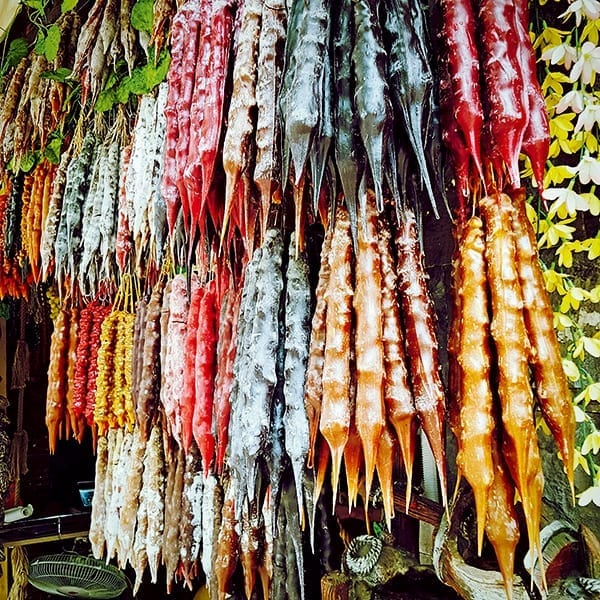Where to eat in Georgia
Sandwiched between the ridges of the Caucasus mountains where Europe meets Asia, the resurgent Silk Road republic, once closed off by the Soviets, now warmly welcomes food-curious travellers.
Tristan Rutherford enjoys flavour-packed cooking in the capital, Tbilisi, and travels to the nearby Kakheti region to sip its highly prized wines.

Bunches of wild asparagus sprout next to a fish tank teeming with trout. Wheels of cheese weigh down a Lada to its bumpers, and strings of dried apricots dangle from the vehicle’s wing mirrors. As the crow flies, Dezerter Bazaar, Tbilisi’s main food market, sits within 200 miles of the borders of Russia, Turkey and Iran. It shows.
Tehrani-style street stalls sell spices such as blue fenugreek and bee propolis (also known as bee glue – a sticky mixture bees produce to mend their hives). The indoor section of Georgia’s largest market – a Soviet-era maelstrom of giant pumpkins, pickles in oil drums and braying beasts – vends wild tea foraged near the Black Sea.
The bazaar juxtaposes treats you couldn’t pair in Georgia’s neighbouring countries. The spices of Arabia are displayed next to an entire row of fresh suckling pigs. Alcohol is sold with such abandon that during my hour-long stroll I was strong-armed into sipping four homemade wines and two shots of chacha, a grape pomace brandy known as vine vodka, which clears the tubes like liquid nitrogen. Pistachios are bagged and sold by Asian nation of origin – Uzbek, Azeri, take your pick.
The most memorable section? That would be the cheese. There is guda, a sheep’s cheese ageing under a sheepskin to guarantee a farm-tastic tang. And dambal’khacho, a mould-covered quark wrapped in paper, aged underground, then served seared in hot butter. Plus nadugi. That’s a cheese inside a cheese: a ricotta-like curd wrapped inside a thin, silken slice of another kind of cheese called sulguni.

There are plenty of healthy offerings too, such as tklapi (fruit leather) made from fresh plums, peaches or apricots, which are cooked down to a paste that’s then spread on a plastic sheet and air-dried. Torn-up bits of sour tklapi can be used as a throat lozenge. Sweet ones are lobbed into a stew. Half the ingredients and dishes I found can’t be nibbled anywhere else in the world.
Fanatically foodie
Long-time resident Paul Rimple summed up Georgia’s crossroads cuisine for me on his Culinary Backstreets Food Tour : “National dishes were cross-pollinated by Georgia’s position on the Silk Road from China to Europe.” Our first stop was a subterranean bakery based round a vast tandoor-like oven. Steaming Armenian-style lavash and Indian-esque paneer naans are sold for pennies. Lobiani are fluffy bread pillows stuffed with beans spiced like an Iraqi bazaar, and khabizgina breads are stuffed with kefir, herbs and mashed potato, providing a digestible dough-on-the-go. “Bread is sacred in Georgia, so it’s never chucked away,” said Paul.

A church farm shop next door reveals a foodie culture that borders on the fanatic. Products sourced from local villages include comb honey, goat curd takeaway cups, and plastic syringes of queen bee serum. “To aid fertility, locals would rather inject one of those in their mouth than visit a doctor,” Paul told me. All products are organic – and also come blessed by a local priest, a bonus in a nation where dining companions are considered ‘guests from heaven’. Church frescoes regularly feature God, the son and a holy toast, with barrels of wine painted alongside. “Even in the USSR,” concluded Paul, “where people cared as little for culinary aesthetics as they did about religion, Georgian cuisine was considered the best.”
The best street snacks on Paul’s £70 full-day tour, which includes lunch and a market trip, are churchkhela. These candle-shaped sweets can be found all around the town and are formed by threading almonds, hazelnuts or walnuts onto string, which is then dipped into cauldrons of bubbling fruit juices – grape in the mountainous east, crushed berries on the western coast – then hung and left to drip-dry. They are calorific, intense and regionally diverse. In other words, Georgian cuisine on a stick.

Ancient and modern
New-ish direct flights from London (see box, right) make it possible to eat your way around Tbilisi over a long weekend. By dishing up culinary history to a modern audience, the country hopes food-loving tourists will keep its traditions alive.
A case in point are the only-in-Georgia dumplings called khinkali, which are served by the thousand each lunchtime at Zakhar Zakharich (3 Right Bank, Mshrali Bridge). The restaurant still makes its dough by hand. Raw pork, lamb or beef is twisted inside each dumpling with garlic, parsley or mushrooms, boiled in herby broth, then served. It’s dim sum, Caucasus-style. The trick is to pinch the doughy topknot (called the kudi, or hat) while sucking out the juices without spilling the unctuous interior. Drinks are also eminently Instagrammable and geographically unique. I sipped tarhun, a sparkling green drink flavoured with fresh tarragon, and planned my dinner.

Sabatono (30 Alexander Griboedov St) is perfect for first-time visitors. It presents a geographical cornucopia of Georgian cuisine in user-friendly surrounds. I kicked off with a pizza-style khachapuri. Like a Turkish pide, it’s a bready boat filled with molten sulguni cheese, with two cracked eggs as crew. Ajapsandali is an aubergine fire-starter of a stew that could have ridden out of Central Asia with Genghis Khan. Sliced aubergine is also rolled around walnut paste, then seared to make badrijani nigvzit wraps.
By the time tkemali sour plum sauce was poured over mtsvadi brochettes, I was broken. For £10 my dinner had spanned the entire country. I could only stagger to Vino Underground (15 Galaktion Tabidze St), a wine bar dedicated to natural wines, serving a huge variety from every corner of Georgia. Better still, with no sulphate hangover I woke up thirsty for more.

Wine of the gods
The road from Tbilisi to Kakheti, Georgia’s main wine region, takes 90 minutes, past meandering rivers and citrus orchards watered by the snow-capped Caucasus peaks that hem in the lush plateau. Grapes grow in wild abandon, some climbing huge mulberry trees that dot the route. In Soviet times only four of Georgia’s 525 grape varieties were allowed to be made into wine. Thankfully, in these isolated parts, that culinary homogenisation policy was impossible to police.
My tasting trip was organised by Living Roots which devises food, foraging and wine tours. Our host was Georgia’s acclaimed winemaker, expat American John Wurdeman of Pheasant’s Tears Winery in the Provence-lookalike wine town of Sighnaghi. His cellar holds not stainless-steel tanks but earthenware qvevri. “Wine ferments inside the giant amphorae buried in the ground,” he explained. “As qvevri leave no metallic, oak or other tang, each vintage speaks Georgian.”

Georgians have been fermenting wine in the same manner for 8,000 years and stalwarts see no reason to alter the method. The country’s historically made wines are now the toast of the wine world.
Outdoors we strolled around Wurdeman’s organic vineyard as birds, bees and butterflies buzzed in the vines. During Soviet times chemical fertilisers were either too expensive or woefully misallocated, so Georgia’s divine terroir was largely left unspoiled. In Pheasant’s Tears’ rooftop tasting salon we cracked open six bottles, including a 2012 made from the chinuri grape, which has become resistant to high altitude frosts and mildew over millennia and produces a silken amber nectar with a faint fizz of mint and pears. It’s unlike anything I’ve sipped before: it’s wine the way it tasted before the industrial age.
Queen of cuisine
The past is alive and well in Georgia but the future of the country’s cuisine can be tracked down in Tbilisi. Sprawling across the ivy-choked courtyard of the Georgian Writers’ Union building is Littera, run by head chef Tekuna Gachechiladze. Not for nothing is she known as The Queen of Georgian Fusion. “In this country we are so obsessed with heritage that we have forgotten our tradition is to invent,”she explained. Tekuna has trailblazed a new trend that serves timeless ingredients with Asian and European élan. To prove the point, she ordered us all 11 items on her starter menu.

In the national stew called chakapuli, which zings with tarragon and white wine, Tekuna replaces the meat with Black Sea mussels. Their ozone whip-crack matches the dish perfectly. Trout is usually grilled but she serves it tartare-style with adjika pepper paste “to preserve its real flavour”. We split the dish in two like old friends – then ordered the same again. “Our food is not globalised,” Tekuna told us, “but we would still like to share it with the world.”
Subscribe to our magazine
Food stories, skills and tested recipes, straight to your door... Enjoy 5 issues for just £5 with our special introductory offer.
Subscribe
Unleash your inner chef
Looking for inspiration? Receive the latest recipes with our newsletter




